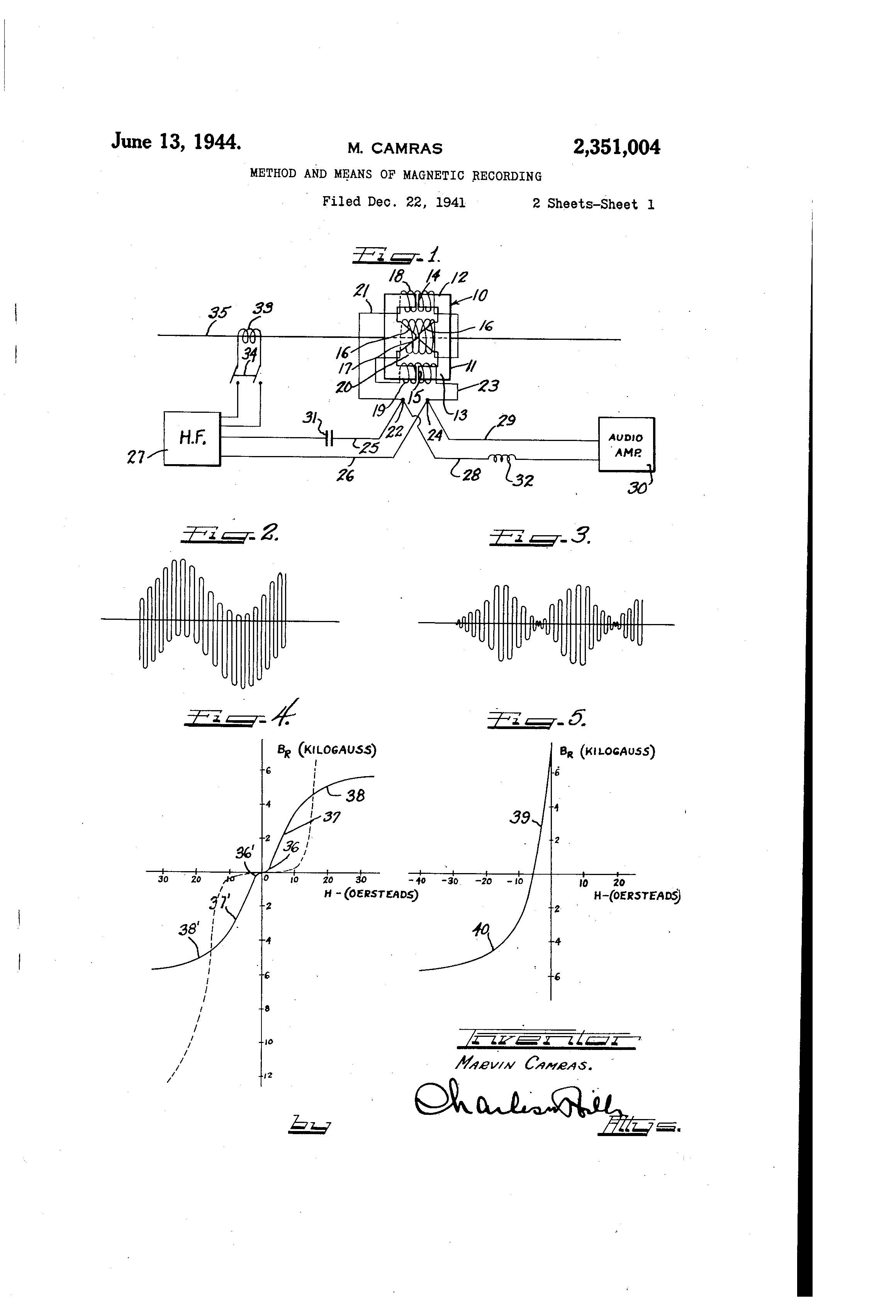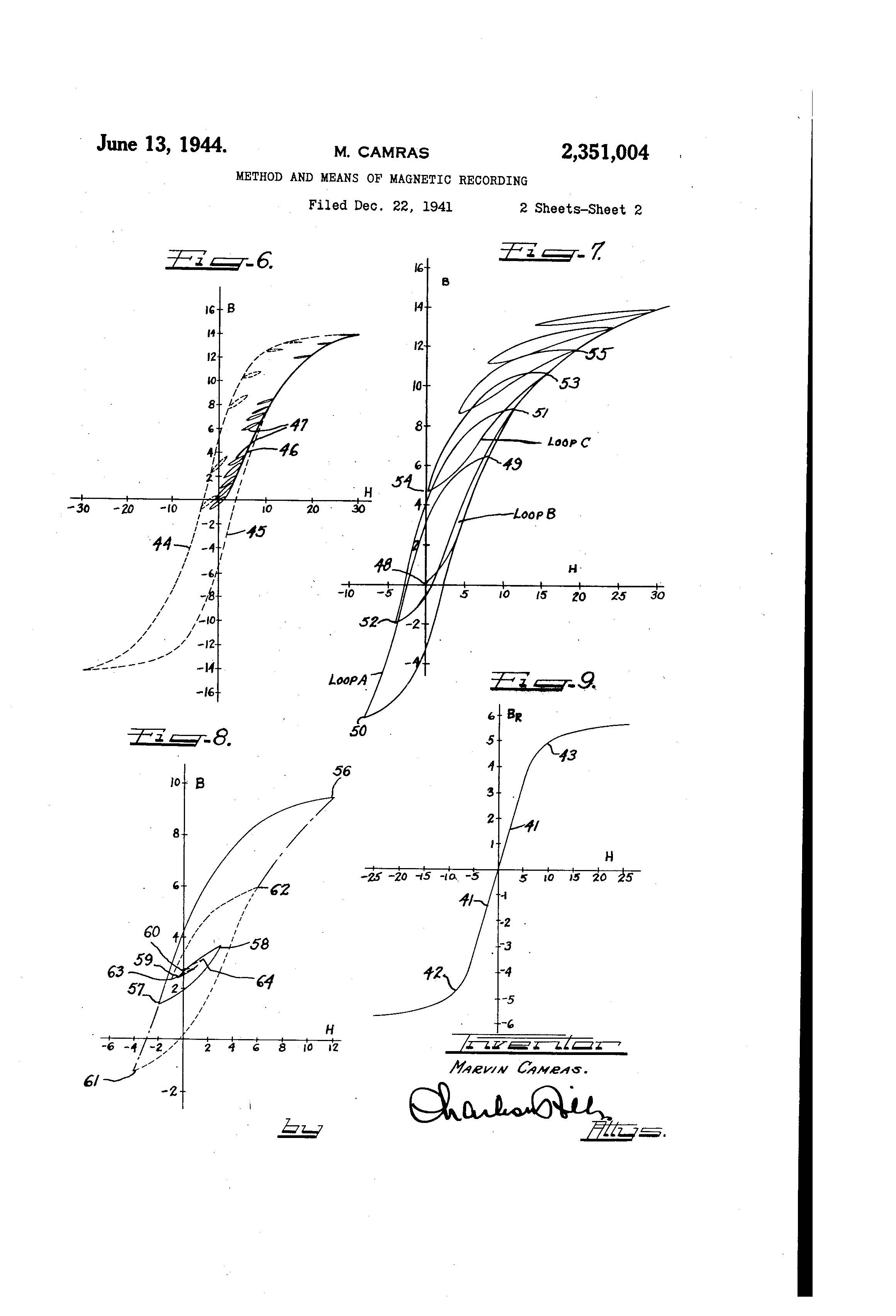Suiter Swantz IP takes a look back at past inventions and inventors with our Patent of the Day.
On this day in 1944, Marvin Camras was granted U.S. Patent No. 2,351,004 for a METHOD AND MEANS OF MAGNETIC RECORDING.
This invention relates to a method and means of magnetic recording, and more particularly, to a system for linearly impressing magnetic variations or recordings on a completely demagnetized steel wire.
A system for magnetically recording audible sounds on a steel wire was developed in 1898 by Valdemar Poulsen. The Poulsen system, as well as other systems developed and experimented with for some years thereafter, included the fundamental concept that a demagnetized paramagnetic body, such as a steel wire or tape, should be passed through a magnetic field whose intensity varied as a function of the fluctuating sound waves to be recorded. These systems, due to the fact that the steel wire was initially demagnetized, operated over and around the lower bend near the zero axis of the characteristic residual magnetization curve of the wire. Because the system operated on a non-linear portion of the residual magnetization curve, faithful recording and reproduction of the sound waves was impossible.
A radical change in the underlying principle of magnetic recording and reproduction was made at a much later date by causing the steel wire or tape to be magnetically saturated and then passing it through an opposite weaker magnetic field modulated by the wave to be recorded. This basic type of system was a tremendous improvement over the earlier system, although the fundamental nature of the system still made it inherently impossible to obtain completely distortionless recording and reproduction. A body which is magnetically saturated without aging or other treatment, such as was necessary in the use of such wire or tape is very sensitive to extraneous demagnetizing effect. It is a well known fact that all permanent magnets immediately after magnetization lose some of their magnetism, and for that reason, most permanent magnets have to be aged. This made the above system very susceptible to noise due to mechanical handling, etc., of the wire or tape. A further cause for distortion occurring in this latter system is due to the fact that the system operates on a curved portion of the demagnetization curve, and although this curved portion is nearly straight, and nothing like the abrupt knee portion of the curve over which the earliest system operated, it nevertheless did cause some distortion to occur.
A modification of this system involved employing a modulated high frequency wave of the exciting current for producing a field to partially demagnetize the saturated record medium. This system retains the same characteristic features as those last discussed above.
An important feature and object of the present invention is to provide a system in which recording is made on a demagnetized paramagnetic body and in which the residual magnetization curve is linear where it passes through the zero position of the residual magnetization curve and continues to remain linear throughout the maximum range of operation.
Another object of the present invention is to provide a new method and means for magnetic recording on a paramagnetic body. A further object of the present invention is to provide a novel method and means for recording on a demagnetized paramagnetic body while operating on a substantially linear residual magnetization curve. A still further object of the present invention is to provide a novel method and means of magnetically recording on a magnetizable body which includes simultaneously impressing a high frequency alternating current and the wave to be recorded thereon.
Still another object of the present invention is to provide a novel method and means for straightening out the lower knee in the residual magnetization curve of the magnetizable body. Another and still further object of the present invention is to provide a novel recording and reproducing head in a system where voice or other sound waves are magnetically recorded on a steel wire and reproduced therefrom. Still another and further object of the present invention is to provide a novel magnetic recording system in which the recording head is energized by a high frequency alternating current connected in parallel with the fluctuating electric current produced by the sound to be recorded.
Suiter Swantz IP is a full-service intellectual property law firm serving all of Nebraska, Iowa and South Dakota. If you have any intellectual property questions or need assistance with any patent, trademark or copyright matters and would like to speak to one of our patent attorneys please feel free to contact us.

